Physical Address
304 North Cardinal St.
Dorchester Center, MA 02124
A blister is a fluid-filled space within or beneath the epidermis. Blisters may occur as a secondary event caused by factors such as infections (e.g., viral, bacterial), ischemia (e.g., vasculitis), burns, or inflammation leading to disruption of the dermal-epidermal junction (e.g., erythema multiforme) or as a primary event in which a genetic mutation or immunologic event affects the structural integrity of the basement membrane zone (BMZ) (e.g., epidermolysis bullosa or pemphigoid, respectively).
Clinical findings are critical for the assessment of a blistering skin disease. Factors that are helpful in the differential diagnosis include age (e.g., whereas bullous pemphigoid [BP] tends to affect elderly adults, epidermolysis bullosa acquisita [EBA] is more common in middle-aged individuals), location and distribution of the blisters (e.g., involvement of mucosal tissues is typical for pemphigus vulgaris [PV] but uncommon in pemphigus foliaceus [PF]; whereas Hailey-Hailey disease affects intertriginous areas, Darier's disease has a seborrheic pattern), gross blister characteristics (e.g., large flaccid blisters are typical of pemphigus, but small erythematous vesicles are more common in eczema), arrangement of blisters (e.g., grouped or herpetiform pattern in dermatitis herpetiformis [DH]; annular or “cluster of jewels” pattern in linear IgA bullous dermatosis [LABD]), associated inflammatory background (e.g., the blisters of BP typically arise on an erythematous base, but those of porphyria cutanea tarda [PCT] are usually present on noninflamed skin), medical history (e.g., connective tissue disease, diabetes, associated malignancy), and recent medications (e.g., relevant for drug-induced LABD, pseudoporphyria, or drug-induced pemphigus).
Identifying the mechanism of tissue split (e.g., spongiosis [ Fig. 5-1 ] versus acantholysis [ Fig. 5-2 ]) and determination of the microanatomic plane of the blister cavity are the first steps in the histologic analysis of a vesiculobullous disorder. Spongiosis reflects intraepidermal edema, leading to separation of keratinocytes from each other, stretching and ultimately breaking intercellular connections (see Fig. 5-1 ). Acantholysis is a manifestation of loss of cell–cell adhesion between keratinocytes. Intercellular bridges disappear and individual keratinocytes change their shape from polygonal to round or oval and develop a smooth outer surface (see Fig. 5-2 ).
| Histologic Feature | Mechanism of Blister Formation | Example |
|---|---|---|
| Spongiosis | Intercellular edema leads to cell separation | Acute allergic contact dermatitis |
| Ballooning degeneration | Intracellular edema leads to cell death and vesicle formation | Herpesvirus infection |
| Acantholysis | Loss of cell-to-cell contact between keratinocytes | Pemphigus |
| Cytolysis | Physical trauma leads to cell–cell disruption or death | Heat, friction |
| Lichenoid reaction with necrosis | Disruption of basal cells caused by inflammation | Erythema multiforme |
| Basement membrane zone destruction | Genetic structural defects or immunologic events | Epidermolysis bullosa, bullous pemphigoid |
| Dermolysis | Sub-basement membrane zone disruption caused by structural defects or immunologic events | Dystrophic epidermolysis bullosa, polymorphous light eruption |
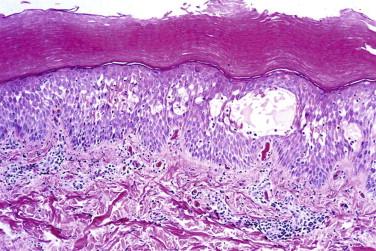
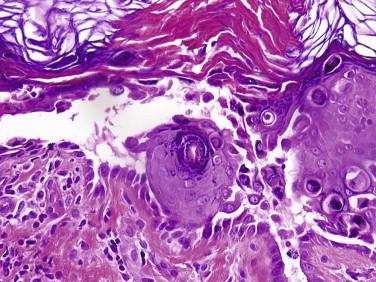
With regard to the microanatomic plane, blisters can be divided into intraepidermal ( Figs. 5-3 and 5-4 ) and subepidermal ( Fig. 5-5 ). However, one must be aware that blisters reepithelialize, and a biopsy of an older subepidermal blister may present with an intraepidermal split. Intraepidermal blisters can be further subclassified into subcorneal and suprabasilar. Assessment of an associated inflammatory infiltrate, if present, is also important because its composition (neutrophils, eosinophils, or both versus lymphocytes versus mast cells) and distribution pattern (papillary dermal abscesses versus diffuse bandlike) may provide useful clues to narrow the differential diagnosis. The detection of microorganisms or viral cytopathic changes may also provide instant evidence as to the nature of a blistering process.
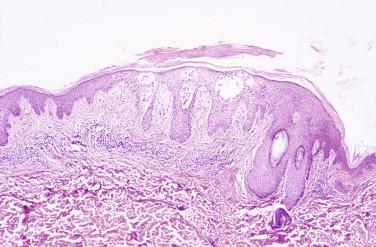
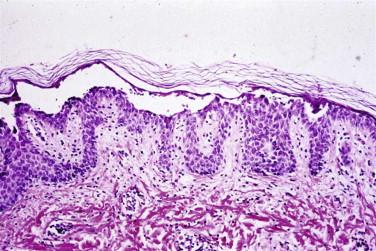
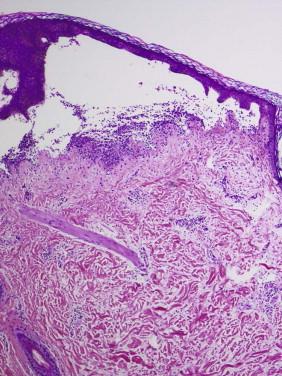
Most autoimmune bullous dermatoses require direct immunofluorescence (DIF) for classification because the histology per se is often not specific. For the assessment of an immunobullous disorder by DIF, it is best to biopsy perilesional skin (i.e., skin within 1 cm of a blister if the skin appears normal or immediately adjacent to erythema if the skin is inflamed). In biopsies that have compromised epidermis, evaluation of the follicular and eccrine epithelium for immunoglobulin deposition may contribute to the diagnostic sensitivity of DIF in bullous disorders with IgG or C3 linear or cell surface immunoglobulin. For DIF, the biopsy specimen should be placed in a transport medium, such as Michel's medium, snap frozen in liquid nitrogen, or sent in saline-soaked gauze if delivery to the pathology laboratory can be made within a few hours. There may be less background with nonfrozen saline–transported specimens. If a specimen is accidently placed in formalin, there may be limited value in quickly removing it and putting it in Michel's medium. After 10 minutes, pemphigoid and DH can retain diagnostic DIF findings (longer for pemphigoid), but longer times in formalin will result in false-negative DIF or nonspecific nuclear staining simulating lupus. Pemphigus antigens are not preserved even after very transient exposure to formalin immersion. Indirect immunofluorescence (IIF) may also be used to help confirm a diagnosis of a bullous disorder of patients with circulating autoantibodies. For some issues, such as the distinction of BP from acquired epidermolysis bullosa, specific localization of the antigen within the BMZ may be necessary. This can be achieved by soaking the tissue in 1 mol/L NaCl solution, resulting in a predictable split within the lamina lucida, followed by incubation of the antibodies for immunofluorescence testing (so-called “salt-split skin” technique).
Histology and IF remain the gold standard for diagnosing autoimmune blistering disease. One needs to bear in mind that immunoreactivity for a certain antigen is not always restricted to one disease entity. For instance, BP180 (BPAG2) is the target antigen for several autoimmune bullous disorders, including BP, mucous membrane pemphigoid (MMP)/cicatricial pemphigoid (CP), pemphigoid gestationis (PG), and LABD. Some immunobullous disorders have similar IF findings. In these cases, tests such as enzyme-linked immunosorbent assay (ELISA) are readily available for the detection of autoantibodies to the specific structural components of the BMZ that are targeted in these disorders. ELISA is helpful to monitor patients because there is correlation between autoantibody titers detected by ELISA and disease activity. Immunoblotting and immunoprecipitation may offer more precise identification of autoantigens. Some of the main autoantigens that can be detected include BP180/COL17 (BP, MMP, PG, LABD); BP230 (BP, PG, LABD); COLVII (EBA); laminin 332 (MMP); α6β4 integrin (MMP); laminin γ1 chain (anti-p-200 pemphigoid); LAD-1 (LABD); desmoglein 1 (PV, PF, paraneoplastic pemphigus [PNP]); desmoglein 3 (PV, IgA pemphigus, PNP); desmocolilin 1, 2, and 3 (IgA pemphigus); and tissue transglutaminase (DH).
Parameters helpful in the algorithmic approach to the differential diagnosis of intraepidermal blisters are the precise localization of the blister within the epidermis (corneal or subcorneal versus spinous cell layer versus within the spinous cell layer or immediately suprabasilar) and the presence of acantholysis versus spongiosis or other features. Spongiotic disease processes (eczematous dermatitides) are described in more detail in Chapter 1 of this book but are briefly mentioned here.
Miliaria crystallina
Bullous impetigo
Staphylococcal scalded skin syndrome
Subepidermal pustular dermatosis
Pustular psoriasis
Acropustulosis of infancy
Transient neonatal pustular melanosis
Erythema toxicum neonatorum
Acute generalized exanthematous pustulosis
Pemphigus variants (especially pemphigus foliaceus and drug-induced pemphigus)
Pemphigus variants
Hailey-Hailey disease
Darier's disease
Grover's disease
Spongiotic vesicles
Herpetic dermatitis
Friction
Edema
Pemphigus (especially pemphigus vulgaris)
Paraneoplastic pemphigus
Darier's disease
Miliaria reflects skin changes caused by blockage of the eccrine duct. The manifestations vary, depending on the level of blockage (intracorneal, intraepidermal, or intradermal).
Miliaria usually affects children, especially neonates. Miliaria crystallina, which results from eccrine duct blockage within the stratum corneum, manifests as clear, small vesicles that tend to break easily, resulting in a collarette of scale. Miliaria rubra is caused by blockage of the eccrine duct within the midepidermis. It manifests as small erythematous papules often topped by microvesicles. It typically occurs on the upper trunk and neck of children or adults. Intradermal blockage gives rise to pustules (miliaria pustulosa).
In miliaria crystallina, there is a noninflammatory subcorneal blister overlying the eccrine unit without inflammation. Blockage of the duct lumen by keratinous debris may be observed. The ductal occlusive features in miliaria rubra are similar, but in addition there is acrosyringeal spongiosis with inflammation. In well-developed lesions, there are subcorneal neutrophils and lymphocytes overlying the eccrine duct ( Fig. 5-6 ). In miliaria pustulosa, there are more prominent subcorneal or intraepidermal microabscesses overlying the ductal unit.
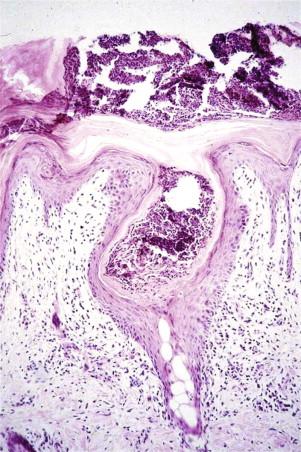
The clinical presentation of miliaria is usually distinct, rarely requiring histologic analysis.
Avoiding conditions that promote sweating (e.g., hot temperatures) facilitates resolution of the lesions.
Bullous impetigo typically affects school-age children and presents as vesicles containing cloudy serous fluid. The blisters frequently break, resulting in superficial round erosions. The blister fluid dries as a honey-colored crust. The lesions are contagious. They tend to be distributed on exposed sites such as the face (especially perioral) and upper extremities. Bullous impetigo is associated with a superficial infection by Staphylococcus aureus phage group 2, type 71. Desmoglein 1, the target antigen in PF, is the proteolytic target of this bacterial toxin.
The blister may be subcorneal or intracorneal. It typically contains neutrophils, but early lesions may be noninflammatory.
A Gram stain usually documents the presence of gram-positive cocci.
The identification of gram-positive cocci distinguishes bullous impetigo from other subcorneal bullous dermatoses. DIF study results are negative.
There is usually good response to topical or oral antibiotics. There may be recurrences.
Staphylococcal scalded skin syndrome (SSSS) is associated with infection from S. aureus phage group 2, type 71. Blistering is caused by the proteolytic effect on the target desmoglein 1 by secretion of the epidermolysin exotoxin produced by S. aureus .
Staphylococcal scalded skin syndrome usually affects young children (neonatal period to younger than 5 years of age) or immunosuppressed adults or older children. Extracutaneous symptoms include fever and upper respiratory tract infection. The skin is erythematous and tender. The bullae, when intact, are large and flaccid ( Fig. 5-7, A ). The blister expands with pressure into the adjacent nonblistered skin, known as the positive Nikolsky sign. Typically, there are broad areas of desquamation with denudation. The mucous membranes are usually spared.
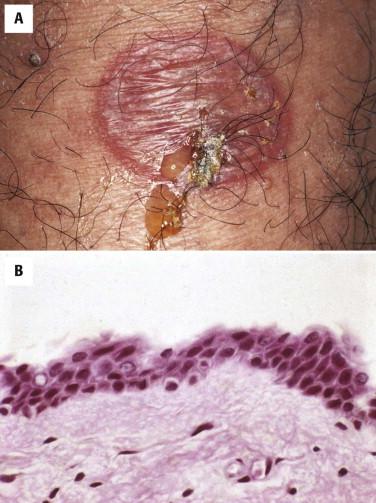
When there is an intact blister, it is within or just below the granular layer. There is minimal, if any, dermal inflammation ( Fig. 5-7, B ). Acantholysis may be present. Often the blister is not intact, resulting in subtle findings of absent granular layer, with subtle acantholysis.
Gram stain and DIF findings are negative.
Gram stains and DIF help distinguish SSSS from bullous impetigo or PF. Clinically, the differential diagnosis usually includes other desquamating conditions, such as Stevens-Johnson syndrome (SJS), toxic epidermal necrolysis (TEN), and pemphigus. TEN and SJS show interface dermatitis, with epidermal necrosis and a split at the BMZ.
Antibiotics are needed to treat the infection.
Typically, black male infants are affected, and they present with small pruritic pustules located on the palms and soles. Lesions are rarely biopsied. The biopsy would show a subcorneal pustule containing neutrophils, admixed with eosinophils. Dyskeratotic keratinocytes may be noted. The clinical course is characterized by exacerbation, in crops, often in the summer. There is spontaneous remission around age 2 to 3 years of age.
The disease has a predilection for black newborns, who present at birth with flaccid, very transient vesicopustules that rupture within 1 to 2 days, leaving dark macules with a collarette of scale.
The lesions are located on the face, trunk, diaper region, palms, and soles. Histologically, intracorneal and subcorneal pustules are found. The lesions are sterile. Gram stain results are negative. The process is self-limited and does not require treatment.
The lesions of this disease present from birth to 48 hours after birth as numerous asymptomatic small pustules associated with ill-defined, blotchy erythematous macules, papules, or plaques, most often on sites of pressure. There are subcorneal eosinophil-rich pustules, typically near a follicle. Biopsies of nonpustular areas will show perivascular or perifollicular eosinophils and papillary edema. The lesions clear spontaneously within a few days.
Subcorneal pustular dermatosis (SPD) tends to present in intertriginous skin of middle-aged women. This may rarely be seen in children. It typically manifests as small flaccid pustules on erythematous or normal skin. The lesions may form serpiginous plaques. The face, mucous membranes, palms, and soles are spared.
Typically, there is a broad subcorneal pustule containing neutrophils and rare eosinophils. The pustules are not follicular based and appear to sit on the top of the epidermis. Acantholytic cells are often seen within and at the edge of the blister. There is a mild neutrophil-rich perivascular dermal infiltrate, with exocytosis of neutrophils.
Direct immunofluorescence study findings are negative. They are needed to exclude IgA pemphigus.
IgA pemphigus shows overlapping histologic and clinical features. Pustular psoriasis may present with similar histologic findings but can be distinguished by the presence of psoriasiform hyperplasia and tortuous telangiectases in the dermal papillae. Acute generalized exanthematous pustulosis (AGEP) may show subcorneal pustules, but these are not as broad and prominent. Clinical correlation is necessary, but dyskeratosis and vasculitis would favor a diagnosis of AGEP. Dermatophytosis should be excluded by fungal stains.
The condition is chronic and relapsing but responds to dapsone. Patients should be evaluated for an IgA monoclonal gammopathy, which is often associated with SPD. Pyoderma gangrenosum; IgA myeloma; and systemic conditions such as rheumatoid arthritis, Sjögren's syndrome, SAPHO (synovitis, acne, pustulosis, hyperostosis, osteitis) syndrome, Crohn's disease, and thyroid disease have been reported in association with Sneddon-Wilkinson.
Acute generalized exanthematous pustulosis is most often (≈90% of cases) caused by a varied and ever-growing list of medications, but viral infections and exposure to mercury may also cause it. Patch testing may yield a positive result in approximately 50% of cases.
Acute generalized exanthematous pustulosis may occur at any age. The eruption of AGEP is characterized by an exanthematous erythema studded with small (less than 5 mm) nonfollicular pustules. The eruption usually has an acute rapid onset and may occur within days after intake of a drug. It frequently begins on the face and intertriginous sites and disseminates quickly. There may be blisters without pustules. Pruritus and a burning sensation are common. Oral mucosal and tongue erosions occur in 20% of cases. Patients are often febrile and may have numerous extracutaneous signs and symptoms.
There is a spectrum of histologic features that are dependent on whether erythema or a clinical pustule is sampled. There is often a mixed histologic picture. Intraepidermal, in particular subcorneal, pustules are typical ( Fig. 5-8 ) even in the erythematous lesions. Subtle acantholysis is commonly observed. Nearly all cases have spongiosis, and most have dyskeratosis. The dermis is edematous, with mixed inflammation, including neutrophils and eosinophils. There may be evidence of mild vascular damage (endothelial cells swelling, purpura, and karyorrhectic debris).
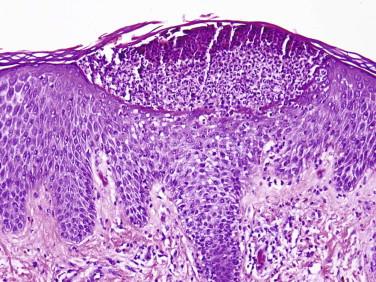
Pustular psoriasis may be difficult to distinguish from AGEP, especially when a more established pustule of AGEP is sampled. The pustules tend to be located higher in the epidermis of pustular psoriasis; they are lower or located at various epidermal levels in AGEP. Additional features that favor AGEP over psoriasis include dyskeratosis, eosinophils in the pustules, as well as the dermis, a mixed neutrophil-rich superficial and mid to deep dermal infiltrate, erythrocyte extravasation, leukocytoclasis, prominent papillary dermal edema, vasculitis, and absence of tortuous dermal papillary vessels. The presence of mixed inflammatory reaction patterns (subcorneal pustules associated with mild interface dermatitis and mild vasculitis) also favors AGEP. Nondiscriminatory features include psoriasiform rete hyperplasia, Munro microabscess, and follicular pustules. Sneddon-Wilkinson SPD will have a broader pustule, with less mixed histologic features.
The condition is self-limiting at 2 weeks after withdrawal of medication. The patients heal with postinflammatory desquamation, which may offer a clue to the diagnosis.
An eczematous dermatitis may develop blisters. This typically occurs in acute contact dermatitis or in dyshidrotic eczema. The blisters are often associated with pruritic erythematous or edematous patches and plaques. In conditions such as poison ivy, vesicles, juicy papulovesicular papules, and plaques are arranged in linear and geometric patterns. Dyshidrotic eczema often occurs in atopic patients but may be the presentation of allergic contact dermatitis. The lesions often start on the edges of the fingers as small “tapioca pudding” type vesicles, but with time, the blisters break, and the condition spreads to involve the palms and soles as scaly or hyperkeratotic patches or plaques.
There is marked spongiosis with intraepidermal vesicle formation (see Figs. 5-1 and 5-3 ). The blister cavity contains serum and variable numbers of mixed inflammatory cells. In addition to spongiotic blister formation, there may be ballooning or reticular degeneration of keratinocytes. Langerhans cell aggregates may be present within the epidermis. A variable perivascular and interstitial infiltrate is seen within the upper dermis. If the condition is caused by contact allergy, there may be numerous eosinophils in the dermis and often also epidermis (eosinophilic spongiosis).
Bullous reactions to arthropod bites may be seen at any age but are more common in children. There are tense blisters of various sizes present on exposed parts of lower extremities. The lesions are asymmetric, often with linear grouping. Fleas are more likely to cause bullous reaction, but this also may be seen with bites from chiggers. In some scabies reactions, especially in children, instead of the typical paucilesional presentation of excoriations and interdigital burrows, rare patients tend to present with a generalized vesicobullous eruption, simulating a bullous disorder. This may be pustular in adults.
Intraepidermal blisters are caused by acute spongiosis or necrosis. There is usually a mixed superficial and deep dermal inflammatory infiltrate of lymphocytes and eosinophils. If there is a pustular reaction, this may be subcorneal, simulating psoriasis. Arthropod bite blisters may also be subepidermal (see the following).
Polymorphous light eruption (PMLE) is a photodistributed reaction to ultraviolet (UV) light (ultraviolet A [UVA] and sometimes ultraviolet B [UVB]), characterized by a pruritic polymorphous eruption, including erythematous papules, eczematous papulosquamous lesions, and vesicles. The condition may occur in children but typically manifests in adults. The face, hands, and chronically sun-exposed sites are classically spared because of “hardening” of these sites. A rare variant localized to the elbows has been described. The eruption occurs with the first sun exposures of the early spring or summer season or during a sunny vacation in the winter season but does not recur until the following season.
The histology is variable, paralleling the clinical morphology. There is usually an element of spongiosis and marked papillary dermal edema. There may be an intraepidermal spongiotic vesicle or a subepidermal separation, resulting from severe dermal edema. In the dermis, there is a superficial and deep perivascular lymphocytic infiltrate. There may be neutrophils and extravasation of erythrocytes.
The condition clears as tolerance is achieved but recurs with reexposure each spring and summer season. Treatment is not necessary because the condition clears with sun avoidance. Steroids may hasten the resolution. Controlled UV exposure may be used to harden the patient before prolonged UV exposure.
Incontinentia pigmenti (IP) is an X-linked inherited disorder.
Incontinentia pigmenti occurs at birth or infancy and is typically seen in girls. Residual changes may be seen in women. The rash has three morphologies, or “stages”: acute vesicular or urticarial, chronic verrucous, and chronic pigmented. The rash does not always progress from one stage to another and may present with later stage features without having shown manifestations of an earlier stage. Clinically, the lesions are typically displayed in swirled patterns and linear arrays on the trunk and extremities. Extracutaneous manifestations are frequently seen and include ocular, dental, and central nervous system abnormalities.
In the acute or vesicular stage, eosinophilic spongiosis with intraepidermal vesicles and microabscesses are characteristic ( Fig. 5-9 ). Dyskeratotic keratinocytes are often present, in particular near acrosyringeal structures. The dermis shows variable pigment incontinence, depending on the stage.
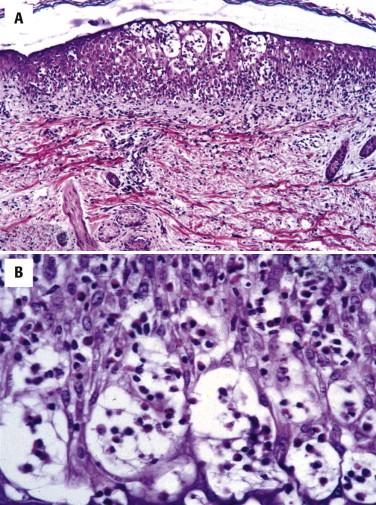
The differential diagnosis includes eczema and autoimmune bullous disorders. To exclude the latter by DIF is helpful. The combination of eosinophilic spongiosis and the distinct pattern of dyskeratosis favor IP over allergic contact dermatitis and autoimmune bullous disorders.
The vesicular stage is transient, but the condition is chronic, with the dyspigmentation persisting throughout adulthood.
Pemphigus is a group of blistering disorders caused by autoantibodies against components of the desmosome in the skin and mucous membranes. Acantholysis is a characteristic histologic feature, reflecting loss of adhesion of keratinocytes to each other from the sequelae of antibody binding to structural proteins. In PF, for example, pathogenic IgG antibody is directed against desmoglein I (anti-Dsg1), a 160-kD desmosomal cadherin. In PV, antibodies are directed against desmoglein 3, a 130-kD transmembrane desmosomal protein that is involved in cell–cell adhesion. Antibodies against desmoglein 1 may also be present.
| Type | Clinical | Histology |
|---|---|---|
| Pemphigus vulgaris (PV) |
|
|
| Pemphigus vegetans (variant of PV) | Initially like PV; older lesions become papillomatous and hyperkeratotic, forming vegetations |
|
| Pemphigus foliaceus (PF) |
|
|
| Folgo selvage | Variant of PF endemic in South America (Brazil) | Similar to PF |
| Pemphigus erythematosus |
|
Similar to PF |
| Drug-induced pemphigus |
|
Similar to PV or PF |
| IgA pemphigus | Serpiginous plaques with peripheral scale and broad pustules |
|
| Paraneoplastic pemphigus |
|
Lichenoid dermatitis with or without suprabasilar acantholysis |
Pemphigus vulgaris presents in the fourth to sixth decades of life and is rarely seen in children. The lesions are flaccid bullae on normal to slightly erythematous skin. Breakage of the blisters results in large denuded or crusted erosions ( Fig. 5-10 ). Generalized involvement may result in exfoliative erythroderma similar to a burn victim. There is a mucous membrane dominant type in which patients have antibodies to desmoglein 3 (Dsg3) and present with prominent involvement of mucous membranes but minimal cutaneous lesions and a mucocutaneous type . In the latter, patients have both Dsg1 and Dsg3 antibodies. The mucosal involvement includes blisters, erosions, and erosive gingivitis. Oral involvement may precede cutaneous lesions by weeks to months. The skin lesions are frequently seen on the hair-bearing areas, such as the scalp and temple; the seborrheic zones of the face, neck, chest, and back; and the intertriginous areas, groin, and trunk. There may be generalized exfoliation, nasopharyngeal, genital, and conjunctival involvement. Precipitating factors include UV light drugs, emotional stress, contact dermatitis, burns, radiation, infection, certain foods and nutritional factors, neoplasms, and, rarely, silicosis. Genetic factors are involved. Relatives of patients with pemphigus have Dsg3 autoantibodies, but blisters usually are not seen. Extracutaneous associations include thymoma and myasthenia gravis.
Onset typically in adults ages 40 to 60, rarely children
Oral mucosa, head and neck, trunk, conjunctiva, intertriginous areas, nasal and anogenital mucosa
Painful oral mucosal erosions common
Flaccid blisters, positive Nikolsky's sign
Large denuded weeping areas
Genital ulcers
Used to be often fatal without treatment (loss of body fluids, malnutrition, and superinfection)
Systemic corticosteroids and other immunosuppressive agents very effective. Biologic agents are effective and offer less toxicity.
Morbidity from chronic steroid/immunosuppressive therapy
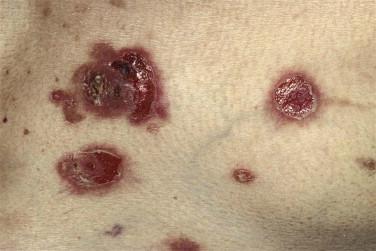
Pemphigus vulgaris may present in a preblistering phase as eosinophilic spongiosis ( Fig. 5-11 ). The histology of a PV blister is characterized by a suprabasilar and often also intraspinous acantholytic split ( Fig. 5-12 ). Acantholysis may extend into adnexal epithelium. When the basal cells detach from each other but adhere to BMZ, the resulting picture of solitary basal cells aligned along the base of the blister has been likened to “tombstones.” Inflammation is usually minimal in an early blister, but a variable infiltrate of lymphocytes, eosinophils, and neutrophils, with or without crusting, may occur with established lesions ( Fig. 5-13 ).
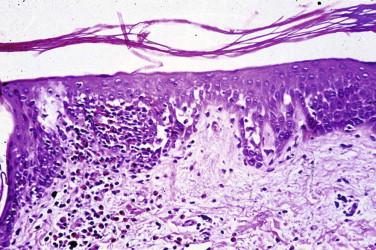
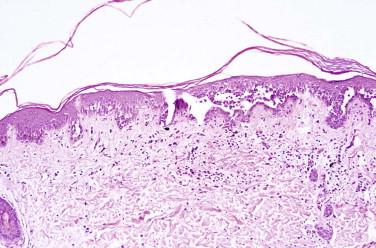
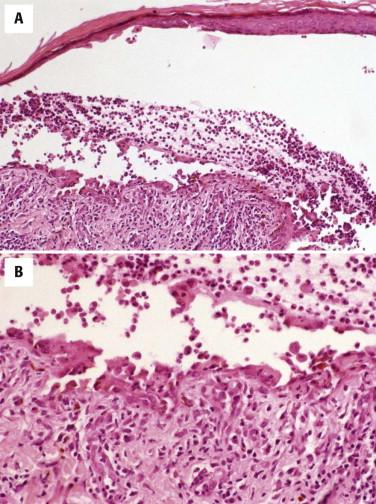
Direct immunofluorescence typically shows IgG and C3 cell surface membrane staining ( Fig. 5-14 ). IIF also shows positive staining. Because antibodies are pathogenic, their titers can be used to follow the disease course. PF and PV have similar DIF findings, but the combined use of monkey esophagus plus human skin can increase sensitivity for detecting pemphigus antibodies to 100%. Sera rich in Dsg3 in PV patients have greater sensitivity on monkey esophagus. Sera from PF patients rich in Dsg1 have greater sensitivity with human skin. The use of these two substrates may be helpful in differentiating PV from PF.
Suprabasilar acantholytic blister
Acantholysis extends down adnexal epithelium
Eosinophils
IgG and complement deposits (C3)
Intercellular/cell surface pattern
Pathophysiology
Autoimmune antibodies to DSG3 (desmoglein III [130 kD]), DSG1, E cadherin
Early lesions (see eosinophilic spongiosis)
Blister: other types of pemphigus
Darier's disease
Hailey-Hailey disease
Tissue artifact
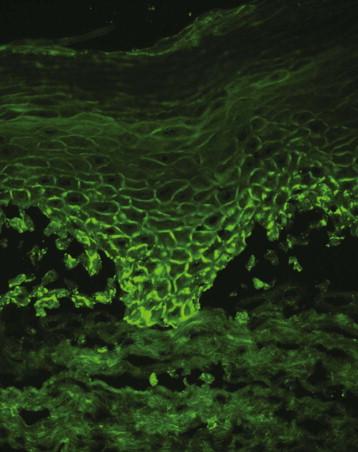
The differential diagnosis includes the various other intraepidermal blisters with acantholysis. A herpetic dermatitis shows viral cytopathic changes and tends to be associated with a denser mixed inflammatory cell infiltrate, often with necrosis or epidermal or follicular epithelium or secondary vasculitis in addition to acantholysis. PNP may be indistinguishable but typically shows lichenoid features. If a patient has as an associated malignancy, one should exclude PNP by immunoprecipitation or at least by screening with IIF against rat bladder epithelium.
Darier's disease differs from PV and other variants of pemphigus by the presence of corps ronds and grains (round and granular bodies), and lack of staining by DIF. Isolated incidental acantholysis (e.g., acantholytic acanthoma) or Grover's disease should not be confused with pemphigus if attention is paid to the clinical context.
Although eosinophilic spongiosis can be a helpful clue to suspect pemphigus, it is seen in a number of other conditions.
Without immunosuppression the course is often fatal because of loss of fluids and secondary infections. The prognosis has been improved with systemic steroids or other immunosuppressive agents, but significant morbidity remains from the disease as well as its long-term treatment.
Autoimmune Blistering Disorders
Pemphigus vulgaris
Pemphigus foliaceus
Bullous pemphigoid
Pemphigoid gestationis
Epidermolysis bullosa acquisita
Allergic Contact Dermatitis
Scabies
Incontinentia Pigmenti
Drug Reaction
Pemphigus vegetans is a rare verrucous variant of PV, affecting intertriginous areas. There is a Neumann type that begins like PV, with flaccid bullae, followed by peripheral pustules that resolve with hyperkeratotic verrucous vegetations. Oral lesions are common. In the Hallopeau type, which tends to have a milder course that may spontaneously resolve, the primary lesion is a pustule, which evolves into verrucous vegetations studded with pustules.
The histology is similar to PV except for the presence of pseudoepitheliomatous, often verruciform, epidermal hyperplasia.
Direct immunofluorescence results are similar to those for PV.
Lesions of pemphigus vegetans need to be distinguished from other pseudoepitheliomatous processes, such as infections (e.g., blastomycosis) or iododermas (e.g., bromoderma). The clinical context is different. Only pemphigus shows a positive DIF result.
Pemphigus foliaceus (PF) typically affects young to middle-aged adults (30 to 50 years old) but may also rarely occur in children. An endemic form called fogo selvagem exists in South America, especially Brazil. There is a distinct variant of endemic PF (EPF), El Bagre EPF, with features similar to the Senear Usher (PF–lupus) overlap subtype.
Scaly, crusted, well-demarcated patches and plaques are found, predominantly located on the head and upper trunk, in particular the midchest and back ( Fig. 5-15 ). Blisters tend to be flaccid but superficial. Often only the peripheral rim of blister is present at the perimeter of a circular erosion. The lesions may be photoexacerbated, especially el Bagre EPF, where there is prominent involvement of eyelids, ocular structures, and eyebrows. Mucous membranes are usually not involved. Psoriasiform erythroderma has been reported. Precipitating factors include UV light, drugs, emotional stress, burns, radiation, or infection.
* Fogo selvagem is an endemic form that is common in rural Brazil.
—Disease Fact Sheet
Adults. Folgo selvagem is seen in children.
Usually localized to seborrheic areas of the face and trunk
May be generalized
No mucosal involvement
El Bagre endemic pemphigus foliaceus (EPF) with ocular and eyelid involvement
Superficial vesicles with positive Nikolsky's sign
Denuded skin, with collerette of residual blister, flaky puff pastry–like scale, exfoliative erythroderma
Ocular symptoms in el Bagre-EPF
Better prognosis than pemphigus vulgaris
Steroids are treatment of choice
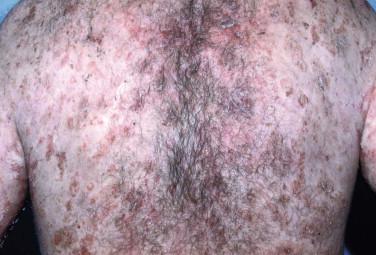
If there is an intact blister, the split will be in the subcorneal layer ( Fig. 5-16 ). Acantholysis typically involves the subcorneal or superficial layers of the epidermis but at times extends down to the follicular infundibulum. It may be present with or without an overt clinical or histologic blister cavity. Acantholytic keratinocytes can be identified in the blister cavity or at the edge of the blister. In the absence of an obvious blister, it is important to carefully examine whether or not the stratum corneum may be focally missing and search for subtle evidence of acantholysis within the granular cell layer ( Fig. 5-17 ). On occasion, no or only minimal acantholysis can be found. In those cases, the presence of neutrophilic or eosinophilic spongiosis may be the only clue to the diagnosis of PF, bearing in mind that PF is only one of several disease entities that may present histologically with eosinophilic spongiosis. Initially, the process may have minimal inflammation, but often there is a perivascular lymphocytic infiltrate with neutrophils and eosinophils in the upper dermis ( Fig. 5-18 ). In some older lesions, there may be subcorneal pustules.
Intraepidermal vesicle in spinous or granular cell layer
Acantholysis
Eosinophilic or neutrophilic spongiosis
IgG and complement deposits (C3)
Intercellular/cell surface pattern
Antibodies to meibomian gland BMZ and intercellular junction, tarsal muscle, and neurovascular structures around pilosebaceous structures of lids in el Bagre EPF
Pathophysiology
Autoimmune antibodies to desmoglein I (165 kD), E-cadherin
Other types of pemphigus
Psoriasis
Staphylococcal scalded skin syndrome or bullous impetigo
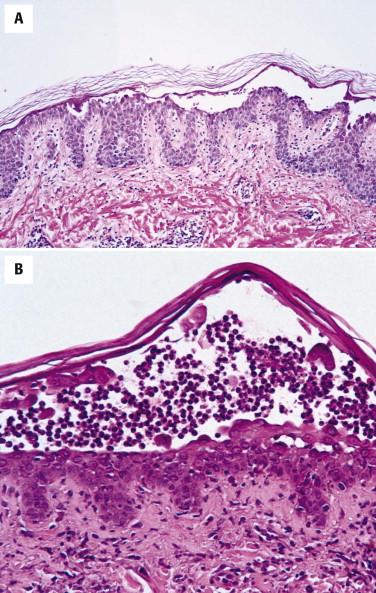
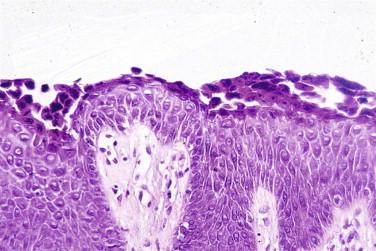
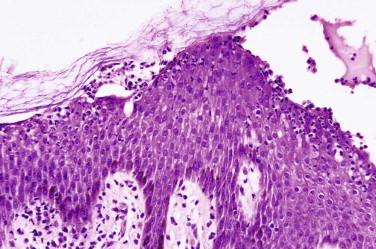
Direct immunofluorescence shows deposition of IgG and sometimes C3 on the cell surface of perilesional skin ( Fig. 5-19 ). Although there is only a split superficially, the staining is noted throughout the epidermis. It may be more prominent in the upper layers as opposed to throughout the epidermis (in contrast to PV). IIF on monkey esophagus typically shows cell surface membrane staining with IgG. This result can be reported as a titer because the amount of antibody will correlate with the disease activity. In up to 25% of DIF and 10% to 20% of IIF, the results may be negative or equivocal. In these instances, ELISA testing can be diagnostically helpful. ELISA is also useful to monitor disease activity.
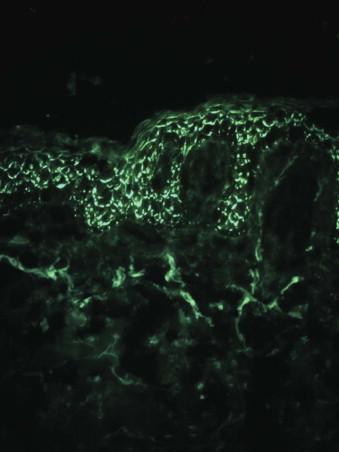
Pemphigus foliaceus may be confused with SSSS, pustular psoriasis, and other variants of pemphigus. The distinction requires attention to associated clinical features and immunofluorescence studies.
Pemphigus foliaceus may respond to topical corticosteroid therapy, but often, systemic immunosuppressive agents are required to control the condition. PF has a better prognosis than PV.
Pemphigus herpetiformis (PH) is a rare variant of pemphigus that presents with a grouped or annular configuration of vesicles. These pruritic herpetiform vesicles arise on the trunk and proximal extremities but tend to spare the oral mucosa. Histologically, eosinophilic or neutrophilic spongiosis with intraepidermal or subcorneal microvesicles are often seen. There may be an equal mix of eosinophils and neutrophils. Acantholysis is minimal or absent. Immunopathologic features are heterogeneous. DIF often shows a pattern of superficial intraepithelial intercellular IgG and C3 deposition similar to PF, although a PV pattern may occasionally be seen. IIF shows cell surface IgG. ELISA may show reactivity against desmoglein 1 most often but also to desmoglein 3. Desmocolin 1 has also been found to be a targeted antigen.
Patients with PH have a good prognosis, with a good response to dapsone, unless it progresses to PV.
Certain drugs may cause clinical and histologic features of pemphigus. There may be a prodrome eruption of morbilliform papules and macules, urticarial patches, or annular erythema. The blisters of pemphigus tend to be more PF-like, but a combination of PV and PF can be seen. Drug-induced pemphigus is usually caused by one of two chemically distinct drugs: thiol drugs (containing a sulfhydryl radical) and nonthiol drugs. Phenol drugs or combined phenol and sulfhydryl drugs may induce pemphigus. Penicillamine is the most common culprit and is seen in approximately 7% of those taking the drug for more than 6 months. Captopril is another common cause because it contains a sulfhydryl group similar to penicillamine. Thiol drugs account for 80% of drug-induced pemphigus. Other drugs include penicillins, cephalosporins, enalapril and nonsteroidal antiinflammatory drugs (NSAIDs).
The histology of drug-induced pemphigus is similar to that of PV (suprabasal or intraspinous) and PF (subcorneal). Features of both may be present in the same patient.
Direct immunofluorescence results are similar to PV or PF.
Clinical information (drug history) is essential for the distinction from non–drug-induced pemphigus.
Become a Clinical Tree membership for Full access and enjoy Unlimited articles
If you are a member. Log in here